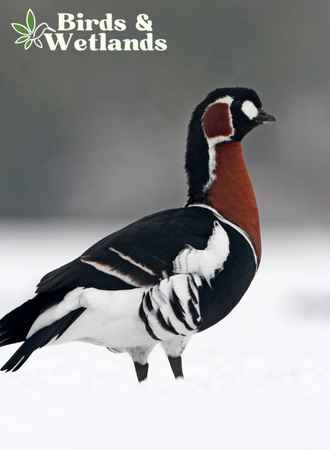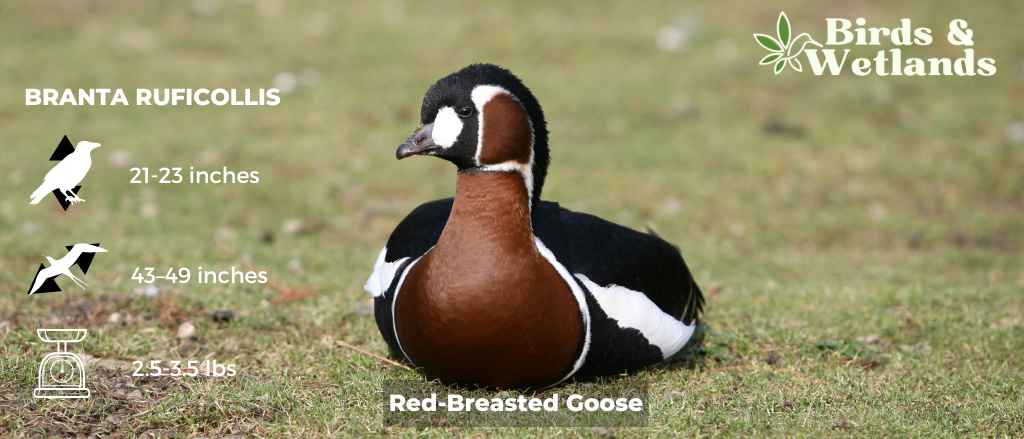The red-breasted goose is a distinctive bird with its brick-red plumage and black-and-white head pattern. With its stocky build and short bill, this beautiful goose is easily recognizable in the wild and highly sought-after in wildfowl collections.
Key Points
The mild climate along the northwestern shores of the Black Sea remains the preferred winter habitats for red-breasted geese during winter months.
Red-breasted geese are omnivores, but they feed primarily on aquatic plants.
The red-breasted goose is a bird species that is smaller than other geese in the same genus.
Red-breasted geese have been facing many threats, with their populations declining dramatically over the years.
Description
The taxonomy of the red-breasted goose was somewhat contentious in the past. Previously, the red-breasted goose was classified as its own separate genus, Rufibrenta.
However, the red-breasted goose appears closely related to the brant goose, Branta bernicla. So, the red-breasted goose now belongs to the genus Branta which also includes the Canada goose.
The Red-breasted Goose is a distinctive-looking waterfowl easily recognized by its striking black-and-white plumage. The crown and nape are black, as are the back, wings, belly, and tail. The upper wing features white wing bars that contrast sharply with the black wings and back, giving this goose a dramatic look.
In addition, the flanks, vent, and undertail coverts are also white in coloration, with dark bars along the rear flanks to help distinguish this bird from other species of geese.
The red-breasted goose is a relatively small goose compared to other birds. In fact, it is the smallest goose in the genus Branta.
In the course of a confrontational display, this goose produces sharp hisses and strikes an intimidating pose, typically with its feathers and nape raised.

Range & Distribution
The red-breasted goose breeds in Arctic Siberia, mainly on the Taymyr Peninsula and in smaller numbers on the Gyda Peninsula and the Yamal Peninsula.
Red-breasted geese spend their winters along the northwestern shores of the Black Sea in several countries, including Bulgaria, Romania and Ukraine. This goose is a relatively rare vagrant in southern Europe. Some flocks overwinter in south eastern Europe.
During their migration, they sometimes congregate with other species, such as brent or barnacle geese.
Due to their prevalence in captivity and popularity among wildfowl enthusiasts, red-breasted geese may be seen far outside their typical wintering grounds. In particular, they are sometimes spotted along the coasts of Great Britain or other areas of western Europe.
Habitat
The red-breasted goose is a species of waterfowl known for its preference for certain habitats. In particular, these geese prefer to nest in dry, open areas like rocky slopes and dry shrubbery and on steep riverbanks.
They can also be found in lower terrain, such as pastures and agricultural fields, where they graze on various plant species. The red-breasted goose often chooses areas near lakes or wetlands as wintering areas.
Their habitat preference often brings them closer to danger. For instance, small colonies of red-breasted geese build nests on the ground too close to Peregrine falcons, making them vulnerable to predation.

Diet
Red-breasted geese are omnivorous aquatic birds that eat water plants and small fish and feed on land grains in agricultural areas. They eat various plant materials, such as sedges, grass leaves, aquatic weeds, and invertebrates like snails and crustaceans.
In addition to these food sources, red-breasted geese will often eat the occasional small insect to supplement their diet, especially during the breeding season.
Population & Conservation Status
The red-breasted goose is a highly vulnerable bird species. This migratory bird’s population has been declining steadily over with an estimated population of just 40,000 red-breasted geese left in the wild.
This species faces an array of environmental threats that have contributed to its rapidly decreasing numbers including oil and gas drilling, climate change, hunting and trapping, land use changes, human intrusions and disturbances at their nesting and feeding sites, and animal predators such as Arctic foxes and the Peregrine falcon.
The many conservation acts, including research and monitoring, land and water protection, species management, and education and awareness programs, are in effect to help the declining population of the red-breasted goose.



